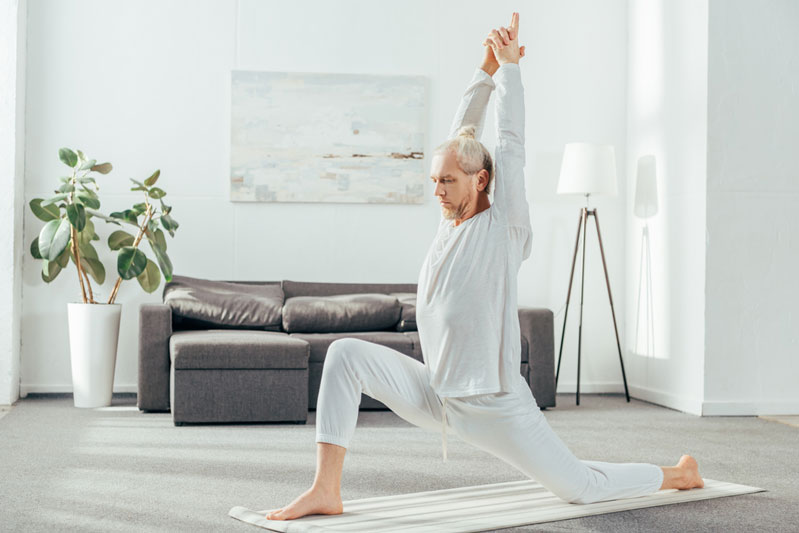At one time, many doctors would tell back pain patients to limit exercise and would advise bed rest.
Times have changed of course and we now know that exercise and remaining as active as possible has a far better outcome for lower back pain than activity cessation.
Why does exercise help back pain?
Activity/movement increases blood flow to the various tissues in the body and can assist the healing process. Healing occurs because nutrients are carried to where they are needed and inflammatory materials get removed from the site of injury.
Not moving enough can weaken your core muscles, make the pain worse over the long term, and also lead to other health problems. Because of this, people who have back pain are often advised to get more exercise and keep active.

It must be stressed that regular physical exercise has been shown to reduce pain.
What’s more, it’s a good idea to go about your daily life as normally as possible, and not to let the pain limit your activities too much.
Isolating yourself or no longer doing things you enjoy will make it even harder to cope with back pain, I think many of us can relate to that these past 18 months or so.
Although exercise programs don’t always make back pain go away completely, they often relieve the pain and improve your overall fitness and mobility.
Research has also found that doing regular exercise can reduce the frequency of recurring back pain attacks by almost half.
The type of activity one chooses must not place undue stress on the damaged tissues so exercise selection must be considered carefully.
Some of the best activities for lower back pain
Walking
Swimming
Weight training
Yoga
Walking
Walking is one such activity that is recommended fairly frequently in connection with chronic back pain and for good reason. Nutrition of the lumbar disc is dependent upon fluid moving in and out of the disc which arises from the disc being loaded and decompressed in a cyclical fashion.

Although walking provides a low compression cyclical load it has been hypothesized that it may enhance disc nutrition and the ability to adapt to spinal loading.
Walking is a low impact activity which places your spine in a neutral position and can contribute to your cardiovascular health and at higher intensity may have the ability to help reduce disc herniations if these are present.
Swimming
Swimming is another activity that is often recommended and this too can be a useful tool in remaining active.
However, care must be taken in which stroke is used. Breast stroke can put unnecessary stress on the lumbar spine due to the nature of spinal extension required in this swimming stroke.

The regular front crawl or stroke along with back stroke places the spine in a more neutral position and would be the swimming strokes of choice I would select for increased activity without undue stress.
Weight training
Strength training can help alleviate your lower back pain and improve your ability to perform everyday activities.
Before you start though, make sure you talk it over with your doctor and get his/her consent.
You should also seek out a suitably qualified therapist/trainer who can assist with creating the correct exercise plan for you based upon your underlying condition.

To protect your back whilst strength training avoid exercises that involve extreme or abrupt jerky moves.
We need to start slow and steady. Focus on resistance training that takes advantage of the eccentric (where the muscle lengthens under tension) and concentric (the muscle shortens under tension) strengthening.
Yoga
Yoga is one of the more effective exercises in dealing with back pain as it can be helpful in strengthening the muscles that support the spine and help stabilize your vertebrae.

But unfortunately, yoga is also the source of many back-related injuries, especially among older adults.
Therefore before jumping into yoga make sure you meet with the instructor before the class and explain your condition to them so they are aware of your limitations. Some people are too shy to admit they have limitations and end up placing themselves in positions that can actually exacerbate existing back problems.
Don’t be afraid to speak up!
What can help you stick to an exercise program?
In order for it to help in the long run too, you have to stick to your exercise program. This requires a lot of motivation, and many people find it tough after a while – particularly if they have a very busy job or home life.
It is very important to find a way to fit the exercise into your daily routine.

What are some ways to get more exercise into your daily routine?
– Take the stairs instead of the elevator or escalator
– Getting off one stop early before your actual bus or tram stop, and walking the rest of the way
– Trying to walk as much as possible throughout your day
– Getting up and walking around while you’re talking on your phone
The link between exercise, endorphins and pain
A very important aspect of remaining active whilst rehabbing a lower back problem or to eliminate chronic pain is the pain relieving properties of exercise.
Benefits of exercise for chronic pain have been previously reported in the scientific literature and one hypothesis for the benefits revolves around endogenous opioids, popularly known as endorphins.

These are neuroactive peptides (short strings of amino acids) that can reduce pain and anxiety and enhance mood. They do so by acting on the same opioid receptors in the central nervous system as opioid pain medications.
Researchers have recently discovered that these feel good endorphins contribute to pain relief and can reduce chronic lower back pain in sufferers.
Conclusion
Continuing to be active or starting an activity plays a large part in managing/healing chronic pain. It is something which should be not overlooked and should form part of your rehabilitation routine.
Just be sure to start off slowly and to choose an activity that will not place undue stress on your lower back and associated tissues.
I actively encourage exercise as part of my lower back recovery program as the benefits to be had are too big to ignore.
If you would like more useful hints and tips for healing your back/sciatica pain sign up here for my weekly emails.
I hope you have found this information helpful and useful please feel free to share this with others who may be suffering from lower back pain.
Let’s spread the love people!

